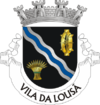Lousã
| Lousã | |||
|---|---|---|---|
| Municipality | |||

The Baroque-style municipal hall
|
|||
|
|||
 |
|||
| Coordinates: 40°7′N 8°15′W / 40.117°N 8.250°WCoordinates: 40°7′N 8°15′W / 40.117°N 8.250°W | |||
| Country |
|
||
| Region | Centro | ||
| Subregion | Pinhal Interior Norte | ||
| Intermunic. comm. | Região de Coimbra | ||
| District | Coimbra | ||
| Parishes | 4 | ||
| Government | |||
| • President | Luís Miguel Correia Antunes (Socialist) | ||
| Area | |||
| • Total | 138.40 km2 (53.44 sq mi) | ||
| Population (2011) | |||
| • Total | 17,604 | ||
| • Density | 130/km2 (330/sq mi) | ||
| Time zone | WET/WEST (UTC+0/+1) | ||
| Postal code | 3200 | ||
| Area code | 239 | ||
| Patron | São Silvestre | ||
| Website | http://www.cm-lousa.pt/ | ||
Lousã (Portuguese pronunciation: [lowˈzɐ̃]) is a municipality in the district of Coimbra, in the central part of Portugal. The population in 2011 was 17,604, in an area of 138.40 km².
The oldest evidence provides an indication of a human presence in this territory from the Roman occupation of the Iberian peninsula. Examples of this include the funerary pyres, rooftops, tile, glass utensils, coins and the remains of the roadways, in various points of within the municipality, including the urban perimeter of Lousã and Serpins. In addition, in the valley and Serra de Ceira there are vestiges of important gold exploration attempts.
With the invasion of the Germanic people, Imperial Rome fragmented, and many of the colonies dispersed, resulting in a loss of information for this period. But, in 943, there was a contract between Zuleima Abaiud and the abbey Mestúlio in the Monastery of Lorvão where, for the first time, the toponomic name Arauz appeared to designate the central place in this region, near a granite wall that later became the point where the Castle of Arouce was constructed. Coimbra, at the time, was the central place in the Mozarab culture, which was rich due to its economic activity, resulting in a diffusion of settlements to the north of Portugal.
Only with pacification of the Mondego valley in the 9th century, allowed the development of Lousã basin. It was Sisnando Davides who was responsible for the conquest of the territory, and reorganization of the territory, which included the reconstruction of the various castles, such as in Coimbra, Montemor-o-Velho, Penela, Pencova and Lousã/Arouce. Legend suggests that Lousã was founded by an emir, named Arunce, who wanted to protect his daughter Peralta, while he was away on campaigns in Northern Africa.
The Counts of Lousã, descendants of a Portuguese conqueror, António Correia, whose coat-of-arms is decorated with a depiction of the severed head of King Muqrin, the last Jabrid ruler of Bahrain, killed by Correia in battle.
...
Wikipedia


